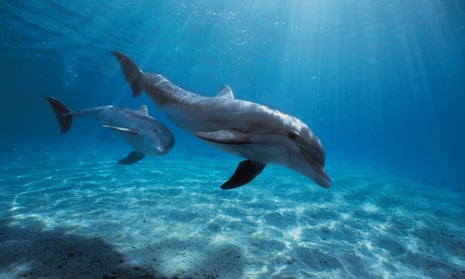England’s only resident population of bottlenose dolphins has been identified by researchers.
Experts analysed thousands of sightings and photographs from the south west of England between 2007 and 2016. They identified 98 individual bottlenose dolphins and were able to define a distinct group of 28 that were resident throughout the year.
These dolphins were present in shallow coastal waters mainly in Cornwall – particularly St Ives Bay and Mount’s Bay – but also in Devon and Dorset.
Ruth Williams, marine conservation manager at the Cornwall Wildlife Trust, described the research as “incredibly exciting”.
“Further work is needed but this is a huge step forward and I am proud of what our partnership between Cornwall Wildlife Trust, scientists and boat operators has achieved,” she said.
“The future of these iconic animals is in our hands and we need to make sure the few we currently have in the south-west are given the protection not just to survive, but to thrive.”
Rebecca Dudley, of the University of Plymouth, analysed 3,843 records to identify the resident population of dolphins.
She gathered data from a large number of collaborators between 2007 and 2016, studying the dolphins’ social structure and distribution.
Bottlenose dolphins can be recognised by their dorsal fin, which has a distinctive shape and markings. A dorsal fin is as unique to an individual dolphin as a fingerprint is to a human. The trailing edge of the fin is most commonly used to identify a dolphin as it is the most distinguishable area. This is because it is susceptible to tearing and, once torn, the tissue does not regenerate, causing permanent notches.
Conservationists say the discovery could have implications for the conservation of the dolphins, who currently receive no specific protection in their home range. Dolphins are a wide-ranging species, with strong evidence needed to show that an area is important before protection can be considered.
The UK’s other two resident bottlenose dolphin populations – in the Moray Firth in Scotland and Cardigan Bay in Wales – both have protection.
A spokesman for Cornwall Wildlife Trust said: “Bottlenose dolphins in the southwest face several threats, including pollution from plastics and chemicals, injury by fishing nets, and disturbance from recreational activities.
“Highlighting the existence of a resident population is the first step in seeking specific protection for these animals, with the next step being to collect more evidence on their movements and behaviour and strengthen the case for the importance of this area.”
The trust launched the Southwest Bottlenose Dolphin Consortium, a partnership between scientists, research groups and eco-tourism operators, in October 2016.
